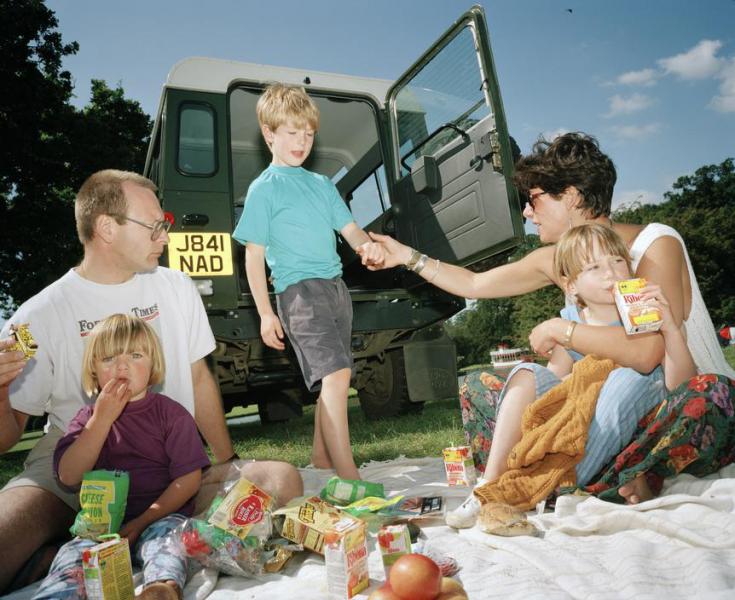
October 2014
“When I first bought the car I couldn’t wait to catch a reflection of myself in a shop window. It’s terribly embarrassing to admit but I really enjoyed seeing myself in the car”.
Martin Parr
Born in 1952, British photographer Martin Parr - himself the son an amateur photographer – has authored many works in his field. He has likewise distinguished himself as an editor (of his numerous exhibitions), a professor and a documentary film production assistant. With his unique, frank view on British society, his work - what one could call a ‘social documentary’ - has earned him international recognition and acclaim.
This body of work on the automobile documents the many imaginaries that surround it and that interest the scientific literature in general. The series of portraits of drivers, whose stories unfold through the photos, gives us the feeling that the myth perpetuated by the automobile and its omnipresence have made it an ideal ‘vehicle’ for imaginaries. The images offer direct access to these imaginaries, rendering them immediately comprehensible. With Martin Parr’s work, the car-objet speaks for and expresses itself by itself, without need for text or explanation. They are what research calls structural stories, and, here, are presented in their most successful form – as facts that require no proof (Freudendal-Pedersen 2007). Enthusiasm for the car and all-car policies have been hot topics for decades. With these photographs, this enthusiasm speaks for itself.
Structural stories
When it comes to the car, drivers willingly give spontaneous, virtually automatic explanation - we could call ‘structural stories’ - to justify their use of it (Freudendal-Pedersen, 2009).
In spite of the passing landscapes, motorways and drivers with their hair blowing in the wind, the book looks deeply at the issue of social mobility. Parr emphasises social mobility to show its close correlation to travel made possible by use of a car. With this work, he revisits the social structure of English society, showing both its vertical and horizontal dimensions.
Horizontally, statements by drivers reveal how they take on a unique role behind the wheel. Even though people often play a role in their daily lives outside of the car, this role immediately becomes more intense upon contact with the later. Women described enjoying games of seduction in their cars, which offer a safe, protected environment, Men saw their company cars as symbols of their social status and rank within the company hierarchy.
Vertically speaking, the photos reveal the success and social ascension long addressed by classic sociology. The magnitude of the car’s social role makes this necessary. In such a context, alternative modes are categorically eliminated from among the possibilities. Thus does the artist reveal social spaces wherein altermobilities have very little chance of emerging.

Social Mobility
Approaching mobility involves a comprehensive approach that includes both its social and its spatial expressions (Mobile Lives Forum – Lexicon – Mobility, by Vincent Kaufmann: https://fr.forumviesmobiles.org/reperes/mobilite-446).
With the works of Sorokin and the Chicago School in the 1920s, mobility was defined in terms of change and movement in space (Mobile Lives Forum – Lexicon – Mobility, by Vincent Kaufmann: https://fr.forumviesmobiles.org/reperes/mobilite-446).
Following Michel Bassand’s work, mobility could then be described as all movement involving a change of state for the actor or system in question. With this definition, mobility has both spatial and social qualities, thus restoring its richness (Mobile Lives Forum – Lexicon – Mobility, by Vincent Kaufmann: https://fr.forumviesmobiles.org/reperes/mobilite-446).
Horizontal and vertical mobility
In Social Mobility (1927), Sorokin identified vertical mobility, which involves upward or downward movement on the socio-professional ladder. Horizontal mobility, which describes a change of status or category, involves no change in the relative position on the social ladder (Mobile Lives Forum – Lexicon – Mobility, by Vincent Kaufmann: https://fr.forumviesmobiles.org/reperes/mobilite-446). Altermobilities
Altermobilities are travel practices that do not involve the exclusive use of a private car. They may also call for the right to slowness, supposing a unique relationship between geographic and social spaces in conjunction with limited car use (Mobile Lives Forum – Lexicon – Altermobilities, by Emmanuel Ravalet: https://fr.forumviesmobiles.org/reperes/altermobilites-448).
The automobile myth and all that to which it has given rise is omnipresent in Parr’s work, thereby excluding any form of altermobility. The necessity of having a car has established it as a norm and, as such, has given it the capacity to produce deviants. The fact that it has become a norm makes the question of whether its use is actually chosen or merely tolerated difficult to answer. The ambivalence of the car - a source of freedom and constraint - is very much marked in Parr’s work. However, the myth of autonomy continues to be perpetuated, as the car still succeeds in keeping the world at arm’s length, thanks to the windscreen. In Parr’s work, the car is an intermediate environment, a buffer zone between the private and public spheres rendering the transition from one to the other less brutal.
Parr’s photos often capture how cars become living spaces. People experience their cars as places of privacy, wherein emotions can be felt in completely safety. (Sheller, 2004). Even empty, cars reflect their owners’ use of them, as the interiors of company cars - whose essentially professional function we can glean from the lack of personalisation - demonstrate. Many activities can be done in the passenger compartment (Laurier 2008), both at rest and in motion. Indeed, the scenes showing occupants engaged in such or such activity inside the vehicle, or gathered outside it with the doors and boot open, are numerous.
The car as a safe living space
The car cannot merely be seen as an easy way of getting from point A to point B (Urry, 2006); it is in itself the reflection of a lifestyle, an extension of the self. As such, it is easily anthorpomorphised, i.e. by giving it a name or attributing certain characteristics to it (Sheller and Urry, 2000). As a refuge and safe place for living and emotions - of which we observe a wide range - it is reveals how we see our own world (Sheller, 2004; Löfgren, 2008).

By underlining the power of the car-object’s presence throughout the book, Parr uses it as a way of representing the worlds of its users. The extension of the driver’s qualities to the car itself converges here to echo Beckmann’s concept of motile hybrid (2004). The hybridisation of man and machine results in an intertwining and muddling of characteristics, so that it is no longer possible to say who is mobile – the car or the driver (Böhm, 2006).
The car-driver and man-machine hybridisation
The car can be seen as an extension of the body – a hybrid form of man and machine. As such, the car’s body is an extension of the human body; its ‘assemblage’ with the driver creates a kind of social being. In addition to having human traits attributed to it, the car also comes with a hybrid assemblage of human skills and desires, with the car, roads and structures linked to them resulting in the idea of the car-driver (Beckmann, 2004; Thrift, 2005; Dant, 2004). There is a veritable ‘interlacing’ between the humanised vehicle and the ‘automobilised’ driver.
Many of the shots capture motility and its constituents. For the people to whom the artist introduces us, access to the car-object has been granted, even if the difficulty of the acquisition process varied from case to case. The individuals’ skills are varied and are clearly presented (at the wheel, socialising, reading maps, etc.), all of which attests to the organizational skills and information use involved in mobility.
Motility
Motility is defined as a set of personal characteristics that enable individuals to move, namely social conditions of access, skills and mobility projects. Motility thus refers to the social conditions of access (the conditions needed to ‘use’ the offer, broadly speaking), the skills required to use this offer and mobility projects (the actual use of the offer to materialise these plans (Mobile Lives Forum – Lexicon – Motility, by Vincent Kaufmann: https://fr.forumviesmobiles.org/reperes/motilite-45).
Three points relative to ways of representing some of these concepts can be added to our reflections on Parr’s work:
The first is the way Parr shows the great sociological diversity of drivers. Instead of grouping them into set categories, which may initially disturb the viewer and potentially impede the imaginaries and interpretations of his work, the photos are ultimately the reflection of the many different relationships one can have with a car, given differences of gender, age, household composition and income. The car is both a medium for the myth of freedom and independence and a tool for social distinction.
The second technique is that of humour, so often used in the arts. Humour lends to our understanding of the work and how we interpret it by giving us direct access to the imaginaries of the automobile through photography.
The third technique offer us information about the imaginaries of automobile mobility. The ‘rawness’ of the photos and apparent intrusion in people’s social space is heightened by the use of the flash, giving the photos a harsher look but providing an immediate understanding of the mobility concepts that interest us here.
The combination of the techniques described above reflects the specific approaches artists use, which we must learn to combine with those of research.
For the Mobile Lives Forum, mobility is understood as the process of how individuals travel across distances in order to deploy through time and space the activities that make up their lifestyles. These travel practices are embedded in socio-technical systems, produced by transport and communication industries and techniques, and by normative discourses on these practices, with considerable social, environmental and spatial impacts.
En savoir plus xAltermobilities represent all the alternative behaviours to an exclusive use of the private car for travel. They also imply a certain right to be slower, and pre-suppose that geographical and social spaces will be organised in ways that take into account a more limited use of cars.
En savoir plus xMovement is the crossing of space by people, objects, capital, ideas and other information. It is either oriented, and therefore occurs between an origin and one or more destinations, or it is more akin to the idea of simply wandering, with no real origin or destination.
En savoir plus xA lifestyle is a composition of daily activities and experiences that give sense and meaning to the life of a person or a group in time and space.
En savoir plus xOther publications